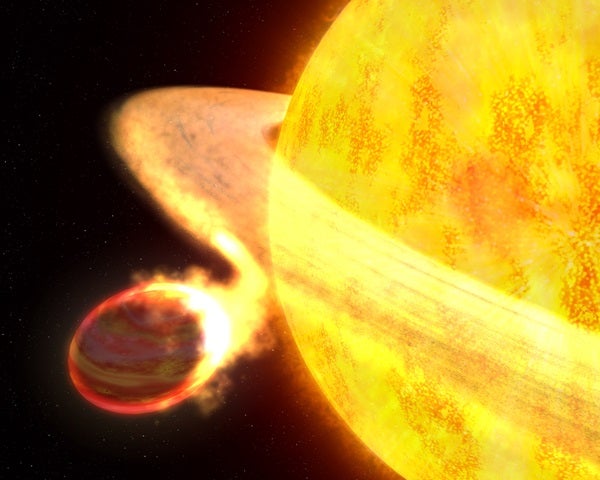A rare exoplanet around a fast-burning star may be too hot to handle, but it might not be around too long, anyway. The feverish gas giant reaches temperatures as high as a dim star as it travels around its young host every day-and-a-half as it slowly spirals inward on a path of destruction. The planet is one of only a handful of worlds known to exist around such a young star, and the star is one of the most massive young suns known to host a world.
Stars form from clouds of hydrogen and helium drawn together by gravity. Eventually the clump is massive enough to kick off hydrogen fusion in its core. Most stars are like the sun, and don’t change much over their 10-billion-year lifetime. More massive stars like KELT-9 transform on shorter timescales, earning the term ‘unevolved.’ Early in their lives, these stars expand outward early in their life to a more stable state. Since most observed stars are older and evolved, the odds mean that finding a young star before it reaches this stage rare enough. Spotting a planet around one is even more unusual.
Close-orbiting gas giants are also intriguing, because they suggest a process unseen in our solar system, where the gas giants lie out past the asteroid belt. Whether gas giants form close to their stars or are sent spiraling inward after interacting with natal material is an ongoing question for scientists.
The planet “KELT-9b happens to be a rare test case in that it orbits this younger, unevolved massive star,” said Karen Collins at the Division on Dynamical Astronomy meeting last month in Nashville, Tennessee. The star itself weighs in at more than twice the mass of the sun. Collins, a researcher at Vanderbilt University in Tennessee, is part of the team that detected the planet using the Kilodegree Extremely Little Telescope (KELT), two robotic telescopes located in Arizona and South America. She is currently in the process of submitting the research for publication.
Weighing in at about twice the mass and twice the radius of Jupiter, the planet reaches temperatures as high as 3400 Celsius (6200 Fahrenheit), making it hotter than some red dwarf stars. Traveling so near its sun, the planet gets doused with radiation that dramatically heats its surface.
“It’s so close to the star, it’s just getting blasted,” Collins said.
The planet’s fiery state means that its bloated atmosphere produces a second signal similar to a pair of stars orbiting one another. To make sure that they didn’t detect a stellar dance, Collins and her team used a second technique known as Doppler tomography to verify the presence of a bloated gas giant. According to Collins, the technique works especially well with rapidly rotating stars like KELT-9.
Scientists only have a handful of years to study the planet KELT-9b. Though it currently orbits the polar region of its star, Collins expects that the planet will shift its orbit as it swings around the pole, changing not only its angle relative to the star but also the length of its year.
“In a few tens of years, we probably won’t see this planet anymore for about a thousand more years, and then it will come back around,” Collins said.
To detect the planet, Collins and her team study light blocked as the planet moves between Earth and its star. As the planet’s path around its sun changes, it will stop blocking the light headed toward Earth for a thousand years, until its orbit brings it back into sight.
According to Aaron Boley, an assistant professor at the University of British Columbia in Canada who studies planet formation, the planet’s tipped orbit adds to its intrigue. Because planets form from the relatively flat disk of gas and dust that usually lines up around the equator of the star, their orbits should stay relatively close to that plane. The tilted orbit, combined with the possible migration of the planet, suggests that KELT-9b may have interacted with another planet. In her presentation, Collins hinted at the possibility of a second planet but shied away from making a definite statement. Such an interaction could have sent KELT-9b spiraling in toward the star.
Planets aren’t the only way to create a polar orbit. If the now-depleted disk of dust and gas formed at an angle to the star, or if interactions between the star and its disk tilted the material, “all bets are off,” said Boley. KELT-9b could have traveled in thanks to interactions with the material, without the need for neighboring worlds.
Either way, the planet probably doesn’t have long to live.
“We do expect KELT-9b to be destroyed by tides or engulfed as the orbiting host star swells during evolution,” Collins said.
Until then, the planet provides an excellent chance to determine how stars and planets evolve together.
“We’ll definitely be going back,” Collins said.










